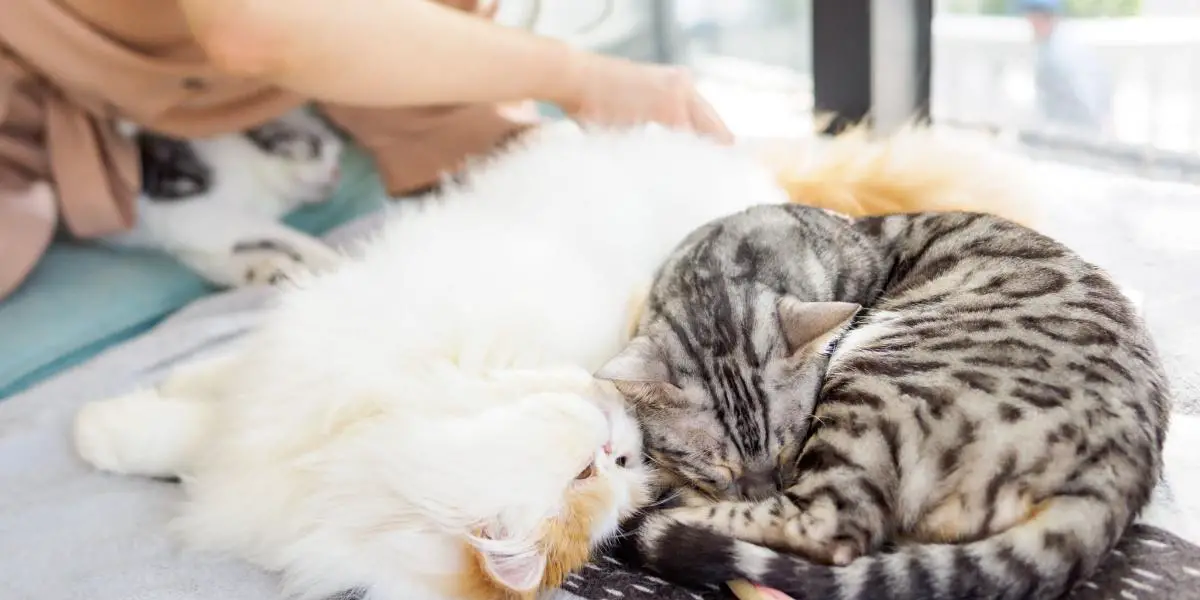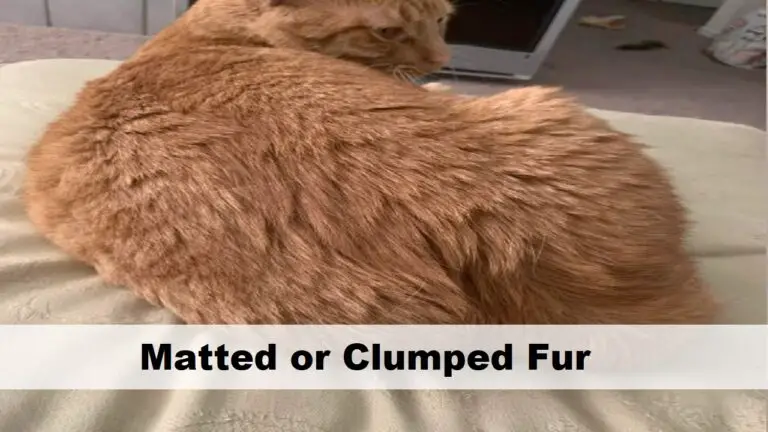My Cat Won’t Let Me Clean Her Bum. What To Do?

If your cat won’t let you clean her bum, gradual desensitization may be a helpful way to get your cat accustomed to the process. You can start by simply petting and touching the area near her tail, gradually moving closer to the area that needs cleaning. This can help her become more comfortable with being touched in that area. Using treats or positive reinforcement can also be helpful. Over time, she may become more tolerant of cleaning.
Many cats, however, do not like their but being touched or cleaned because it is a sensitive part of their body, rich in nerve endings. Besides, cats are naturally self-groomers and may feel uncomfortable if they think you’re infringing on their personal space. Cats may also resist being cleaned due to pain, especially if the cat has any medical conditions.
RELATED:
- How Do Cats Clean Their Bums After Pooping?
- Maggots On Cat’s Bum: Causes, Treatment, And Prevention
- Do Cats Clean Their Paws After Pooping (Or Are They Dirty)?
Teaching your cat to groom herself is a natural process that usually doesn’t require human intervention. Kittens learn grooming habits from their mother. Nevertheless, some kittens may not have learned this especially if they were separated early from their mother. If the cat isn’t grooming herself, it could also be due to health issues, obesity, or old age, which may limit her flexibility. In such cases, it might be necessary to step in and help, which should be done gently. Always consult with a vet if your cat stops grooming herself.
Why Won’t My Cat Let Me Clean Her Bum?
Cats may display a lot of unexpected behaviors at the slightest touch of their bum and in some cases it’s accompanied by some level of aggression or panic. Let’s look at what causes cats to resist when you try to clean their bum.
Your Cat’s Bum Is Highly Sensitive
The first thing to understand is the unique sensitivity of a cat’s rear end. This area has a high concentration of nerve endings, making it especially sensitive to touch. Much like humans, cats can feel discomfort or even pain when this delicate area is handled inappropriately. This can make your cat defensive or agitated when you try to clean her bum. The key is to be as gentle and respectful as possible, acknowledging that this is a highly sensitive area for your feline friend.
Cats Are Self-groomers
Cats are renowned for their cleanliness and self-grooming habits. They spend up to half of their waking hours grooming themselves, employing their tongues and teeth to stay clean and neat. This grooming extends to their rear end as well. It’s an activity they are programmed to perform from kittenhood, learning from their mother’s actions.
Your intervention, no matter how well-intentioned, might feel like an invasion of their self-grooming regimen. They might see this as a violation of their personal space and could respond with resistance or even aggression. Understanding this instinctive behavior can help you approach the task with more tact, ensuring you respect your cat’s instincts and autonomy.
She Hates Water
If your cat is running away from a damp cloth, it likely due to their natural aversion for water. Many cats dislike water because it makes their fur heavy and uncomfortable, it’s an unfamiliar sensation, and they may feel they have less control over their movements. It can also lead to them feeling cold, as their fur is not fully water-resistant. If you must use water on your cat, make sure it it warm to maintain your cat’s body temperature.
Stress/Anxiety
Stress and anxiety can be another significant reason why your cat won’t let you clean her bum. Cats can be sensitive to changes in their environment or routine. Whether it’s the introduction of a new pet, moving to a new home, or even the presence of an unfamiliar person, any change can lead to increased stress levels in your cat.
In such states of heightened stress or anxiety, cats can become more defensive and less tolerant of being handled, even by their trusted humans. This includes resistance to cleaning procedures that they would otherwise tolerate in a more relaxed state. To mitigate this, it’s crucial to identify and reduce potential stressors for your cat. Creating a calm and predictable environment can help your cat feel safe and secure, increasing the chances of her letting you help with her grooming needs.
Medical Issues
If your cat’s rear area is inflamed, infected, or injured in any way, she will likely resist any attempts at cleaning due to the associated pain. Conditions such as anal gland issues, urinary tract infections, or even a physical injury can make the area very sensitive to touch.
In these cases, your cat’s behavior may change. She may become more aggressive or skittish, especially when you approach her rear end. You may also notice changes in her bathroom habits, like frequenting the litter box more often than usual or appearing to have difficulty or discomfort when relieving herself.
Reasons Why Your Cat Won’t Groom Himself
Your Kitten Is Inexperienced
Mother cats play an essential role in teaching their kitten’s fundamental life skills, including grooming. If a kitten is separated from its mother too early, it may not have had the chance to learn these critical behaviors.
As a result, such a kitten may not understand how to properly groom itself, including cleaning its rear end. This situation underscores the importance of allowing kittens to stay with their mothers until they are adequately weaned, typically around eight to twelve weeks of age. If you adopt a kitten who’s missed out on these lessons, you may need to guide them gently, using pet-friendly wipes to clean them and then stroking their fur in the direction of growth to mimic a mother cat’s grooming.
Obesity
Obesity can have significant effects on a cat’s ability to groom itself. Due to their increased body size, obese cats may struggle to reach certain areas of their bodies, such as their bum. This can lead to a lack of cleanliness and potential health issues. To prevent this, it’s important to maintain your cat’s healthy weight through a balanced diet and regular exercise.
Illness
Certain health issues can also interfere with a cat’s grooming habits. Pain, discomfort, or a general feeling of malaise can discourage a cat from grooming itself. Dental issues, for example, can make it painful for a cat to use its tongue and teeth for grooming. Similarly, skin conditions or parasites can make grooming uncomfortable. If your cat suddenly stops grooming itself or does so less frequently, it may be a sign of underlying health problems, and it would be wise to consult a veterinarian.
Old Age
As cats age, they may face physical challenges that affect their grooming habits. Conditions such as arthritis can make the bending and stretching involved in grooming painful. Reduced mobility may also limit their ability to reach their rear end.
Cognitive decline associated with aging, like feline cognitive dysfunction (a kind of dementia in cats), can also lead to decreased grooming. In such cases, owners may need to step in more frequently to assist with their cat’s grooming needs. Always be gentle, patient, and considerate, as older cats can be more sensitive to touch and may tire more easily.
Teaching Your Cat To Groom Himself
We’ll explore practical and effective strategies to teach your cat to groom himself better, thereby reducing the grooming workload for you and promoting a healthier and cleaner lifestyle for your pet. Get ready to embark on this paws-itively rewarding journey to self-grooming proficiency with your cat!
Stroke And Brush Her Regularly
Regular stroking and brushing of your cat serve multiple purposes. Firstly, it mimics the grooming actions of a mother cat, which can stimulate your cat’s natural grooming instincts. Secondly, it helps keep your cat’s coat clean by removing loose hair and potential dirt or debris. It also spreads natural oils evenly across your cat’s fur, which can enhance its shine and health. Lastly, regular brushing can help reduce hairballs, a common issue in cats that groom themselves frequently.
Choose a brush that is appropriate for your cat’s fur type. Some cats might prefer a softer brush, while others might enjoy a firmer one. Start gently and observe your cat’s reactions to ensure she is comfortable.
Clean Your Cat With Pet Wipes Or Damp Cloth
You can also teach your cat how grooming works by cleaning her with pet-friendly wipes or a damp cloth. Make sure the wipe is unscented and remember to always be gentle and careful around sensitive areas, to make the experience as comfortable as possible for your cat.
Bathe Your Cat
While many cats are known for their dislike of water, some may tolerate, or even enjoy, baths. If your cat is one of these exceptions, you can bathe her periodically with cat-friendly shampoo. Make sure the water is lukewarm and not too deep. Also, avoid getting water in your cat’s ears or eyes as it can cause discomfort or even lead to health problems.
Positive Reinforcement
Positive reinforcement is a powerful tool for teaching your cat new behaviors, including grooming. After each grooming session, reward your cat with her favorite treat, a gentle stroke, or a few minutes of playtime. This will help her associate grooming with positive experiences, making her more likely to tolerate or even enjoy it in the future.
Through patience, gentleness, and persistence, you can guide your cat toward better grooming habits. Remember, every cat is unique, so it’s essential to tailor your approach to your cat’s preferences and comfort level. Your vet can also provide guidance based on your cat’s specific health needs and temperament.
How To Get Poop Out Of Cat Fur (Whether Fresh, Dry, Or Runny)
How do you clean a cat’s dirty bum if she won’t let you?
Now, you have understood the reason behind your cat’s resistance and how to teach your cat to self-groom, you may still need some level of human intervention depending on the situation. This task may appear straightforward at first, but gaining some key insights ahead of time can help ensure a smoother process.
Gather Your Cleaning Supplies
The first step is to assemble all the tools you’ll need. This can vary depending on the needs of your cat, but generally, a gentle pet-safe wipe or a clean, soft, damp cloth will be your main tool for cleaning. You may also need a towel to help wrap or dry your cat, a brush for grooming, and if your cat is okay with water, a cat-friendly shampoo for more extensive cleaning. Some cats might have long fur around their rear end, so a pair of grooming scissors could be helpful for a trim, but only if you’re confident and careful not to hurt your cat. If mats are an issue, a mat splitter or comb could be beneficial. Having everything on hand before you start ensures a smooth process and reduces stress.
Approach Your Cat Calmly And Ensure She Is Comfortable
Your attitude will significantly impact your cat’s receptiveness. Cats can pick up on tension, so maintaining a calm demeanor is important. Start by gently petting your cat and speaking softly to create a relaxing atmosphere. Choose a location where your cat feels safe, preferably a quiet and warm room. It can be helpful to have a familiar blanket or cushion for your cat to sit on during the cleaning process. The goal is to create an environment that feels as non-threatening as possible.
Get Some Back-Up
If your cat is particularly resistant to cleaning, consider involving another person – ideally, someone your cat knows and trusts. This person can focus on comforting your cat by stroking her and keeping her calm, while you concentrate on the task at hand. This must be a cooperative effort, to keep the cleaning process stress-free and efficient.
Offer Your Cat Treats
Using treats as a form of positive reinforcement can make the cleaning process more acceptable to your cat. You might want to offer a treat before you start, to create a positive association with the cleaning routine. You can also provide treats during the cleaning, particularly after any difficult moments, and at the end to reward your cat for their cooperation. This can help your cat form a positive association with the cleaning process over time.
Burrito Your Cat Or Hide Their Face
Wrapping your cat in a towel (often referred to as the “burrito” method) can be a useful technique for calming her. The wrap provides a sense of security and limits mobility, reducing potential resistance. You should ensure the wrap is firm but not too tight, and it’s best to leave her head uncovered. Some cats also respond well to having their eyes gently covered with a soft cloth while you clean them, as this mimics the way cats feel when they’re grooming themselves and can help to calm them.
Give Your Cat A Gentle Stroke
Physical reassurance can go a long way in keeping your cat calm. Throughout the cleaning process, continue to gently stroke your cat, particularly on her back and behind her ears – areas most cats enjoy being petted. This can help keep her relaxed and reinforces the bond between you, even while you’re carrying out a task she may not initially find enjoyable.
Cleaning Your Cat’s Bum
With your cat calm and the necessary supplies to hand, you’re ready to begin cleaning. Using your pet-safe wipe or damp cloth, gently clean the soiled area. It’s important to wipe from front to back to avoid spreading any waste to other parts of her body. If your cat is tolerant, a mild, cat-safe shampoo can be used for a deeper clean, but be sure to rinse thoroughly and avoid any internal areas. Always remember to keep the process gentle and make sure to dry the area thoroughly afterward to prevent irritation.
Consider Waiting Till Your Kitty Is Asleep
If your cat is particularly resistant to the cleaning process, you might consider waiting until she’s in a deep sleep. Cats are usually more relaxed and less likely to resist grooming efforts while they’re sleeping. However, this approach requires extreme care to avoid startling or upsetting your cat. If you choose this method, be sure to proceed very gently and stop immediately if your cat shows signs of distress.
Trim Your Cat’s Fur
The outline mentions ‘Trim Your Dog Fur’, but I’m assuming you mean ‘Trim Your Cat’s Fur’. If your cat has long hair, trimming the fur around her rear can help keep it clean and prevent future messes. Use a pair of cat grooming scissors, and be extremely cautious not to nick the skin. If you’re uncomfortable doing this yourself, a professional groomer or veterinarian can do it for you.
Inspect Your Kitty’s Rear End
After cleaning, take a moment to inspect your cat’s rear end. Look for any signs of redness, swelling, or irritation that might indicate a health problem. If your cat has been scooting her bum on the ground, she might have impacted anal glands, which a vet should examine. Also, check for parasites, like worms or flea dirt, which can often be found in this area.
Final Thoughts
Ultimately, it’s important to approach this task with sensitivity, patience, and understanding. Remember that each cat is unique, and what works for one might not work for another. Don’t rush the process; instead, try different techniques until you find what’s most effective for your feline friend. In addition to maintaining hygiene, the process of cleaning can provide an opportunity to check your cat’s overall health, offering you a chance to detect any potential issues early.
As we strive to ensure our cats’ cleanliness and health, we should respect their boundaries and make efforts to teach them self-grooming habits, making the process more autonomous and less stressful for both parties involved. But remember, if you ever feel uncertain or overwhelmed by your cat’s grooming needs, it’s always best to seek advice from a veterinarian or a professional groomer.
By cultivating patience, and understanding, and employing these strategies, you can transform the grooming session from a potentially stressful encounter into an opportunity to strengthen the bond between you and your feline companion. Here’s to a cleaner, happier, and healthier life with your beloved pet!
Read related posts about





